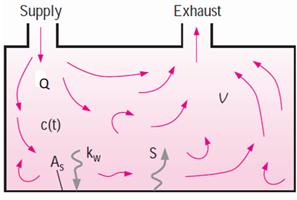) Room ventilation is an important area of environmental and architectural engineering for the application of fluid mechanics. Suppose there is a source S (mass per unit time) of air pollution in a room of volume V. Examples include carbon monoxide from cigarette smoke or an unvented kerosene heater, emissions from household cleaning products, and vapors given off by evaporation of volatile organic compounds from an open container. Let C represent the mass concentration (mass of contaminant per unit volume of air) and Q represent the volumetric flow rate of fresh air entering the room. If the room air is well mixed so that the concentration is uniform throughout the room, but varies with time, the differential equation for mass concentration in the room is: Where kw is an adsorption coefficient and As is the surface area of walls, floors, etc., that adsorb some of the contaminant. V.dC/dt = S-QC-Aw.As.C Write the primary dimensions of the first three additive terms in the equation, and verify that those terms are dimensionally homogeneous. Then determine the dimensions of kw. Use Cmax, the maximum allowable concentration of the pollutant, along with the other parameters V, S, kw, Q, and As to rewrite the equation in dimensionless form. Identify any established dimensionless groups that may appear. Use C* = C/Cmax and t*=Qt/V.
) Room ventilation is an important area of environmental and architectural engineering for the application of fluid mechanics. Suppose there is a source S (mass per unit time) of air pollution in a room of volume V. Examples include carbon monoxide from cigarette smoke or an unvented kerosene heater, emissions from household cleaning products, and vapors given off by evaporation of volatile organic compounds from an open container. Let C represent the mass concentration (mass of contaminant per unit volume of air) and Q represent the volumetric flow rate of fresh air entering the room. If the room air is well mixed so that the concentration is uniform throughout the room, but varies with time, the differential equation for mass concentration in the room is: Where kw is an adsorption coefficient and As is the surface area of walls, floors, etc., that adsorb some of the contaminant. V.dC/dt = S-QC-Aw.As.C Write the primary dimensions of the first three additive terms in the equation, and verify that those terms are dimensionally homogeneous. Then determine the dimensions of kw. Use Cmax, the maximum allowable concentration of the pollutant, along with the other parameters V, S, kw, Q, and As to rewrite the equation in dimensionless form. Identify any established dimensionless groups that may appear. Use C* = C/Cmax and t*=Qt/V.
Solid Waste Engineering
3rd Edition
ISBN:9781305635203
Author:Worrell, William A.
Publisher:Worrell, William A.
Chapter4: Mechanical Processes
Section: Chapter Questions
Problem 4.7P
Related questions
Question
- ) Room ventilation is an important area of environmental and architectural engineering for the application of fluid
mechanics . Suppose there is a source S (mass per unit time) of air pollution in a room of volume V. Examples include carbon monoxide from cigarette smoke or an unvented kerosene heater, emissions from household cleaning products, and vapors given off by evaporation of volatile organic compounds from an open container. Let C represent the mass concentration (mass of contaminant per unit volume of air) and Q represent the volumetric flow rate of fresh air entering the room. If the room air is well mixed so that the concentration is uniform throughout the room, but varies with time, the differential equation for mass concentration in the room is:
Where kw is an adsorption coefficient and As is the surface area of walls, floors, etc., that adsorb some of the contaminant. V.dC/dt = S-QC-Aw.As.C
- Write the primary dimensions of the first three additive terms in the equation, and verify that those terms are dimensionally homogeneous. Then determine the dimensions of kw.
- Use Cmax, the maximum allowable concentration of the pollutant, along with the other parameters V, S, kw, Q, and As to rewrite the equation in dimensionless form. Identify any established dimensionless groups that may appear. Use C* = C/Cmax and t*=Qt/V.

Transcribed Image Text:Supply
c(t)
As
Kw
S
Exhaust
Expert Solution
This question has been solved!
Explore an expertly crafted, step-by-step solution for a thorough understanding of key concepts.
This is a popular solution!
Trending now
This is a popular solution!
Step by step
Solved in 7 steps

Knowledge Booster
Learn more about
Need a deep-dive on the concept behind this application? Look no further. Learn more about this topic, civil-engineering and related others by exploring similar questions and additional content below.Recommended textbooks for you

Solid Waste Engineering
Civil Engineering
ISBN:
9781305635203
Author:
Worrell, William A.
Publisher:
Cengage Learning,

Solid Waste Engineering
Civil Engineering
ISBN:
9781305635203
Author:
Worrell, William A.
Publisher:
Cengage Learning,